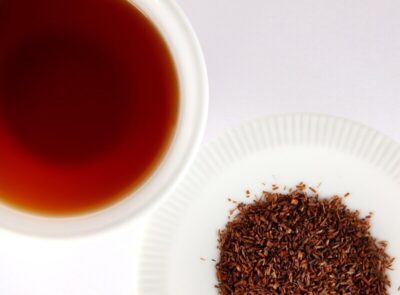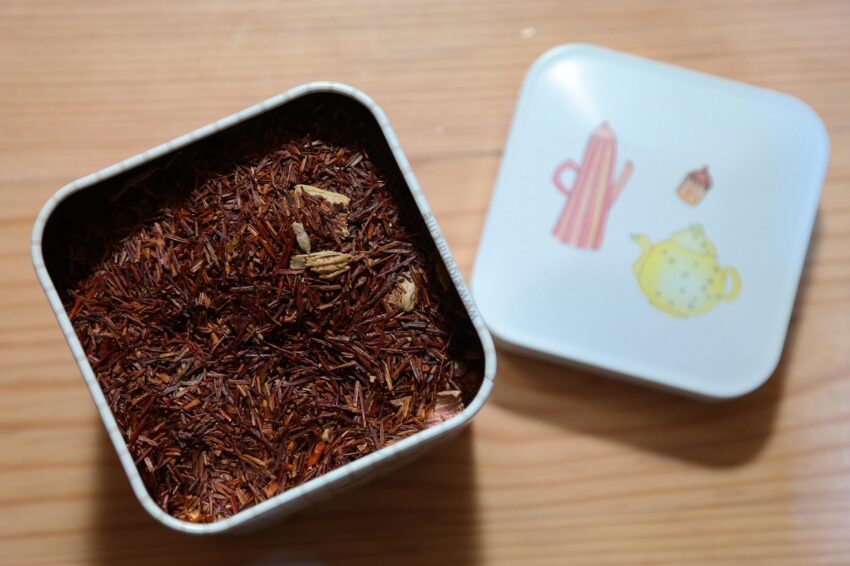YouRooibos Tea
I’ve been drinking some Rooibos tea lately and was curious about it. So, I researched and found a few things to share with my site visitors.
Rooibos tea carries a rich tapestry of cultural significance and a taste that transcends borders. Originating from the rugged Cederberg region of South Africa, this naturally caffeine-free tea traces its roots back to the indigenous Khoisan people. These early communities treasured Rooibos for its health benefits and unique flavor, long before it gained a worldwide following.
 Nestled in the heart of South Africa, the Cederberg Mountains offer the perfect conditions for the Rooibos plant to thrive. This resilient little shrub flourishes in the region’s unique environmental conditions. It’s a legacy handed down through generations, preserving a natural wonder that’s both delicious and steeped in history.
Nestled in the heart of South Africa, the Cederberg Mountains offer the perfect conditions for the Rooibos plant to thrive. This resilient little shrub flourishes in the region’s unique environmental conditions. It’s a legacy handed down through generations, preserving a natural wonder that’s both delicious and steeped in history.
What makes Rooibos stand out from other teas is its journey from a traditional remedy to an international staple. Before it hit the global market, local farmers and traders played a vital role in popularizing this beverage beyond Africa. They unlocked the potential of Rooibos, transforming it into a beloved tea variant that is appreciated worldwide.
For those new to this fascinating tea, knowing where it comes from adds layers of appreciation to every sip. Rooibos is not just tea—it’s a piece of South African heritage shared with tea lovers everywhere. As you enjoy a steaming cup, take a moment to appreciate the generations of history and culture it embodies.
Rooibos Tea: Loose Leaf vs. Bagged
 Choosing between loose-leaf and bagged Rooibos can seem trivial, but it’s all about personal preference and lifestyle. Both options have their own distinct perks and can deliver an equally satisfying cup if you know what you’re looking for.
Choosing between loose-leaf and bagged Rooibos can seem trivial, but it’s all about personal preference and lifestyle. Both options have their own distinct perks and can deliver an equally satisfying cup if you know what you’re looking for.
Loose-leaf Rooibos is often celebrated for its rich, robust flavor that bagged tea sometimes can’t match. When you opt for loose-leaf, you engage more intimately with the tea. You might find yourself relying on a strainer or infuser to prepare it, but many fans of this form say the enhanced taste makes it worth the extra step. Plus, you can control the strength of your brew by adjusting the amount of tea you use. It’s like being a tea artist, crafting your ideal brew.
Conversely, if convenience is your top priority, bagged Rooibos might be your best choice. Throw a tea bag in a mug with boiling water, and you’re set at home or the office. Contrary to some beliefs, bagged tea can still offer a top-tier flavor profile, especially if you invest in high-quality brands.
Ultimately, both have their place, whether you’re leaning towards the engaging ritual of loose leaves or the grab-and-go ease of a tea bag. It’s like picking between two excellent travel routes—it depends on your mood, time, and how much involvement you want in the process. A great tip for those on the fence is to start with a sample of each. See which format fits your taste buds and your daily routine. Remember, the goal is to enjoy every sip, so don’t be afraid to mix it up depending on the season or occasion.
Brewing the Perfect Cup: Steeping Essentials
The secret to a fantastic cup of Rooibos lies in the steeping process. Unlike some teas that demand precision and timing, Rooibos is more forgiving, making it an excellent choice for beginners and seasoned tea aficionados.
A good rule of thumb is to steep Rooibos in boiling water for 5 to 7 minutes. This longer steeping time allows the rich flavors and natural sweetness to develop fully, creating a smooth and aromatic cup. Don’t worry about over-brewing; Rooibos doesn’t turn bitter if left too long, as other teas might.
Temperature plays its part, too. Fresh, boiling water is essential to unlocking the full depth of Rooibos flavors. It finds its sweet spot in the boiling range, so thermometers are unnecessary here.buy
For those looking to experiment, cold brewing offers a refreshing take. Let the Rooibos steep in cold water for several hours or overnight in the fridge. The result? A crisp and naturally sweet, iced tea that’s perfect for warm days.
If you love your tea extra strong, add more amber-hued leaves Playing with the quantity can help you find your perfect balance, tailoring each cup to fit your mood or taste preference.
Remember, the beauty of Rooibos is its flexibility. Whether you keep it simple or like to add a twist here and there, the process is all about enhancing your enjoyment and discovering what best suits your palate.
Enhancing Enjoyment: Best Condiments for Rooibos
Rooibos’s natural sweetness and earthy undertones provide a brilliant canvas for a variety of condiments, making each cup a personal masterpiece. How do I elevate your Rooibos experience? Let’s explore some popular options and a few unexpected twists that might become your new favorite.
 Honey is a classic choice, enriching Rooibos with an extra layer of natural sweetness. It’s like adding a sunbeam to your cup, enhancing the warmth of the tea without overshadowing its character. For those seeking a floral note to accompany the tea’s natural flavors, honey is a beautiful match.
Honey is a classic choice, enriching Rooibos with an extra layer of natural sweetness. It’s like adding a sunbeam to your cup, enhancing the warmth of the tea without overshadowing its character. For those seeking a floral note to accompany the tea’s natural flavors, honey is a beautiful match.
Lemon is another beloved classic. A squeeze of lemon can bring out the tea’s brightness, offering a little zing that complements its smooth, calming base. Some even like to zest some peel into their cup for an aromatic treat.
Looking for something a bit creamier? Milk alternatives like almond or oat milk provide a dairy-free way to add creaminess without losing the tea’s natural allure. These milk options blend seamlessly with Rooibos, creating a rich and velvety texture.
 For those who like to play with flavors, spices can transform your cup into an aromatic journey. A dash of cinnamon, a pop of ginger, or a hint of vanilla can make your Rooibos unique. These spice options boost flavor and bring additional health benefits, making your tea both delicious and nourishing.
For those who like to play with flavors, spices can transform your cup into an aromatic journey. A dash of cinnamon, a pop of ginger, or a hint of vanilla can make your Rooibos unique. These spice options boost flavor and bring additional health benefits, making your tea both delicious and nourishing.
If you’re feeling adventurous, blending Rooibos with fresh herbs like mint or a bit of basil adds a refreshing twist that turns your tea into a refreshing mojito-like brew. Adding a cinnamon stick or a slice of fresh ginger for chilly days can create a warming, spiced infusion.
Feel free to mix, match, and experiment. The key is to find what resonates with your taste buds and enhances your tea-drinking ritual. Rooibos is versatile, and its richness accommodates various ingredients, enabling different experiences in every cup.
Decoding the Name: Fascinating Facts About Rooibos
 Ever wondered where the name ‘Rooibos’ comes from? It’s straightforward but steeped in authenticity. Rooibos, meaning ‘Red Bush’ in Afrikaans, directly describes the tea’s striking appearance. As the leaves are oxidized during processing, they take on a vibrant red hue, a hallmark of this beloved beverage.
Ever wondered where the name ‘Rooibos’ comes from? It’s straightforward but steeped in authenticity. Rooibos, meaning ‘Red Bush’ in Afrikaans, directly describes the tea’s striking appearance. As the leaves are oxidized during processing, they take on a vibrant red hue, a hallmark of this beloved beverage.
Afrikaans, a language with roots in Dutch, highlights the historical influences in the region where the Rooibos plant grows naturally. This name identifies the tea and links it to the indigenous heritage and the Afrikaner farmers who helped commercialize it beyond its traditional boundaries.
Throughout history, Rooibos has been more than just a drink. Thanks to its impressive health benefits, it was used as a barter item and even played a part in traditional medicine. These early utilizations underscore the cultural and economic significance of the plant in South Africa’s localized regions.
Health Benefits
Rooibos is another herbal tea that is rich in antioxidants, and it is caffeine-free, making it a great alternative to traditional black teas. It may help support heart health, manage blood sugar levels, and reduce inflammation, among other potential benefits. Here are some links to studies on PubMed:
- Metabolomic profiling of wild rooibos (Aspalathus linearis) ecotypes and their antioxidant-derived phytopharmaceutical potential
- Aspalathus linearis (Rooibos) Targets Adipocytes and Obesity-Associated Inflammation
- Rooibos (Aspalathus linearis) and its Constituent Quercetin Can Suppress Ovarian Cell Functions and Their Response to FSH
- Impact of Cold versus Hot Brewing on the Phenolic Profile and Antioxidant Capacity of Rooibos (Aspalathus linearis) Herbal Tea
NOTE: I am not a medical professional; please consult your physician for any contradictions when adding supplements to your diet – Shirley
Purchasing Rooibos Online
You can purchase rooibos online easily. Here are some links:
Affiliate Links
This page may contain affiliate links, which, if clicked on, will take you to an item, including information and images. If you choose to purchase the item, I receive a small commission -Shirley
Comments
I do enjoy getting comments and questions from my blog visitors. You can leave yours below – Shirley


Hello Shirley,This is a lovely and informative article that mixes storytelling, education, and personal discovery. It is a standout piece for anyone curious about Rooibos. It’s especially effective for newcomers and casual tea drinkers wanting to explore caffeine-free options that are both flavorful and rooted in tradition.Personally, I haven’t drank any tea for several years due to the caffeine in it. But prior to that I drank a lot of tea, mainly the old standard orange pekoe. Now for some questions.What’s your ideal steeping time to bring out the best flavor in Rooibos? Do you pour boiling water into a cup with the tea leaves and let it set for how long?If you were introducing Rooibos to a friend who had never heard of it, how would you describe its flavor and appeal? Thank you,Mark
Mark, thank you for your comment about my Rooibos tea article. Yes, it’s nice that Rooibos is caffeine-free. Here is the prep: 1-1 1/2 teaspoons of loose leaf, pour 8 oz of boiling water and steep for 5-6 minutes. When I use ppbags, I usually put two bags and then steep 5-6 minutes. I like the flavor a little stronger, and I typically put a little raw honey in my teacup, too. I’ve read where some people will add a little milk (almond milk, usually).Thanks again for visiting my blog site and for your comment. – Shirley
This was super interesting! I’ve heard of rooibos tea before but never actually tried it! I had no idea it was naturally caffeine-free and had so many health benefits. Now I’m really curious to give it a go. Do you recommend starting with plain rooibos, or are there any blends that are especially good for beginners?
Jenny, I’ve been drinking the “double rooibos tea from The Republic of Tea” and using two bags, steeping for 5-6 minutes. I tend to use bagged tea when I can because I order a lot from The Republic of Tea and love their round canister containers, which preserve the tea well. Thanks for visiting my blog site and for your comment. – Shirley
This is such a fascinating read! I love tea. However, I do not get to drink it as often as I would like (I need to change that). However, I am always open to trying new things. One thing I loved about my travels to China – TEA! Rooibos tea looks good and learning the history and origin of it is very intriguing. Thank you so much for this information.
Thank you, Courtney, for visiting my Tea Blog and for your comment on my rooibos tea article. I love the double Rooibos tea bags from The Republic of Tea. I use two bags in my tea and steep it for 5-6 minutes because I like it strong with a little bit of raw honey. Thanks again – Shirley
Several different paragraphs are repeated at the top of the article and confused me at first. You need to go back and edit them out and I got confused by the repetition! I am not a tea drinker as I love my coffee but the article was very informative for those who ate tea drinkers!
John, thank you so much for checking out that article. I’m fixing that now. Editing on my iPhone sometimes makes it difficult and easy to make a mistake due to the small screen. Thanks again, Shirley